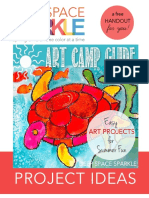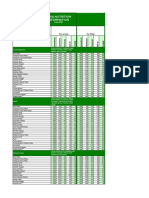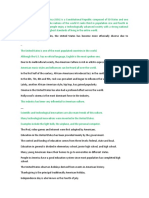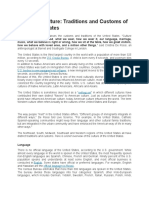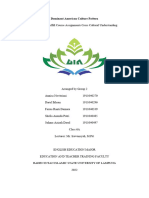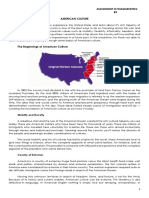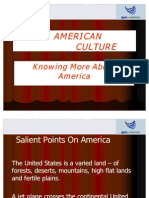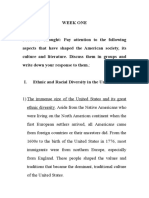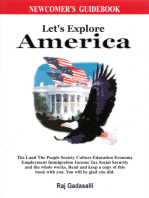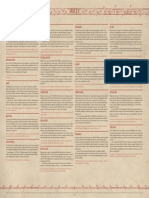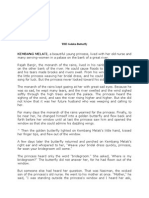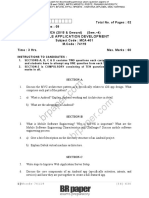0 ratings0% found this document useful (0 votes)
14 viewsUsa
Usa
Uploaded by
Mihaela GrubiiThe document provides an overview of the history, geography, cuisine, economy, culture, people, infrastructure, politics, education, holidays, healthcare, tourism, and fashion of the United States. It covers topics such as the American Revolution, key presidents, geographic features, popular foods, the large economy, diverse music and films, mandatory education, important holidays, healthcare challenges, and top tourist destinations.
Copyright:
© All Rights Reserved
Available Formats
Download as DOCX, PDF, TXT or read online from Scribd
Usa
Usa
Uploaded by
Mihaela Grubii0 ratings0% found this document useful (0 votes)
14 views3 pagesThe document provides an overview of the history, geography, cuisine, economy, culture, people, infrastructure, politics, education, holidays, healthcare, tourism, and fashion of the United States. It covers topics such as the American Revolution, key presidents, geographic features, popular foods, the large economy, diverse music and films, mandatory education, important holidays, healthcare challenges, and top tourist destinations.
Copyright
© © All Rights Reserved
Available Formats
DOCX, PDF, TXT or read online from Scribd
Share this document
Did you find this document useful?
Is this content inappropriate?
The document provides an overview of the history, geography, cuisine, economy, culture, people, infrastructure, politics, education, holidays, healthcare, tourism, and fashion of the United States. It covers topics such as the American Revolution, key presidents, geographic features, popular foods, the large economy, diverse music and films, mandatory education, important holidays, healthcare challenges, and top tourist destinations.
Copyright:
© All Rights Reserved
Available Formats
Download as DOCX, PDF, TXT or read online from Scribd
Download as docx, pdf, or txt
0 ratings0% found this document useful (0 votes)
14 views3 pagesUsa
Usa
Uploaded by
Mihaela GrubiiThe document provides an overview of the history, geography, cuisine, economy, culture, people, infrastructure, politics, education, holidays, healthcare, tourism, and fashion of the United States. It covers topics such as the American Revolution, key presidents, geographic features, popular foods, the large economy, diverse music and films, mandatory education, important holidays, healthcare challenges, and top tourist destinations.
Copyright:
© All Rights Reserved
Available Formats
Download as DOCX, PDF, TXT or read online from Scribd
Download as docx, pdf, or txt
You are on page 1of 3
History
Americans in the thirteen colonies wanted to be free of British
rule. General George Washington led the colonists in the
Revolutionary War The American colonists won the war, and the colonies became
the United States of America. The Constitution became the
highest law of the land, and George Washington became the first
President. President Abraham Lincoln freed the
slaves in the Emancipation Proclamation. The United States grew to be one of the great powers in the
world.
Geography
The U.S. borders both the North Atlantic and North Pacific Oceans and is bordered by Canada and Mexico
It is the third largest country in the world by area and has a varied topography
Like its topography, the climate of the U.S. also varies depending on location. It is considered mostly
temperate but is tropical in Hawaii and Florida, arctic in Alaska,
Cuisine
Seafoods have been in the United States since pre-Colonial times. Native American ate fish and other
seafood in those times.
Pizza is based on the traditional Italian dish which was brought to the U.S. by Italian immigrants. It varies,
however, based on the style and development region.
In the Southern United States, fried chicken is extremely popular, though it is eaten everywhere.
The hamburger most likely first appeared in the 19th or early 20th century.
[1][2]
The
modern hamburger was a product of the culinary needs of a society that was rapidly changing due to
industrialization, and therefore, people had less time to prepare as well as to consume meals.
Economy
The United States of America is the world's largest single national economy
The U.S. dollar is the currency most used in international transactions and is the world's foremost reserve
currency
The United States has one of the world's largest and most influential financial markets
ARTculture
The United States of America is an ethnically and racially diversecountry as a result of large-scale
migration from many ethnically and racially different countries
American artists primarily painted landscapes and portraits in a realistic style
American music styles and influences (such as country, jazz, rock and roll, rock, hip-hop, rap) and music
based on them can be heard all over the world. Music in the U.S. is diverse. It includes African-American
influence in the 20th century.
The cinema of the United States, often generally referred to as Hollywood, has had a profound effect on
cinema across the world since the early twentieth century
People
Americans are raised with a can do mentality and to believe that they can achieve anything, from world
champion horseshoe pitcher to President of the United States of America. They think that if they dedicate
enough energy to it they can have a bigger house, more intelligent children
Infrastructure
general, the United States has an excellent infrastructure. Some areas of the country have aging or over-
burdened roadways and utility systems, but the nationwide infrastructure is capable of supporting the
needs of the economy.
Roadways connect all 50 states and 90 percent of all major cities and towns are serviced by expressways.
The sheer size of the United States necessitates a vast highway network so that goods can be transported
throughout the country
politics
The President of the United States is the head of state of the United States. They are elected by the
American citizens every four years in democratic elections. They also appoint people who will work in
different departments that focuses on special areas for the country
n each state there are governors. They are in charge of their state. They make and pass bills that would
become laws in their countries. There are also two senatorswho represent their state in congress. There
are also representatives who represent a district in their state and also represent them in congress.
Education
School attendance is mandatory primary and secondary levels
Students have the options of having their education held in public schools, private schools, or home
school. In most public and private schools, education is divided into three levels: elementary
school, junior high school (also often called middle school), and high school. In almost all schools at these
levels, children are divided by age groups into grades. Post-secondary education, better known as
"college" in the United States, is generally governed separately from the elementary and high school
system.
Holidays
Third
Monday in
February
Washington's
Birthday
Washington's Birthday was first declared a federal holiday by an 1879 act
of Congress. The Uniform Holidays Act, 1968, shifted the date of the
commemoration of Washington's Birthday from February 22 to the third
Monday in February. Many people now refer to this holiday as "Presidents'
Day" and consider it a day honoring all American presidents. However,
neither the Uniform Holidays Act nor any subsequent law changed the
name of the holiday from Washington's Birthday to Presidents' Day.
[30]
July 4
Independence
Day
Celebrates Declaration of Independence, also called the Fourth of July.
Fourth Thanksgiving Traditionally celebrates the giving of thanks for the autumn harvest.
Thursday in
November
Day Traditionally includes the consumption of a turkey dinner. Traditional start
of the holiday season.
Healthcare
The market-based health insurance system in the United States has caused a human rights crisis that
deprives a large number of people of the health care they need. The most visible problem is the 50
million people without health insurance
While immigrants are generally healthier than the average citizen upon arrival in the United States, their
health tends to deteriorate the longer they remain in the country.
Tourism
Tourism in the United States is a large industry that serves millions of international and domestic
tourists yearly
Today, there exists a wide range of tourist attractions in the United States such as amusement parks,
festivals, gambling, golf courses, historical buildings and landmarks, hotels, museums, galleries, outdoor
recreation, spas, restaurants and sports.
White House Las Vegas Strip Florida Keys Niagara Falls Grand Canyon
Fashion and dress[edit]
A pair of blue jeans
Main article: Fashion in the United States
Fashion in the United States is eclectic and predominantly informal. While Americans' diverse cultural
roots are reflected in their clothing, particularly those of recent immigrants, cowboy hats and boots and
leather motorcycle jackets are emblematic of specifically American styles.
Blue jeans were popularized as work clothes in the 1850s by merchant Levi Strauss, a German-Jewish
immigrant in San Francisco, and adopted by many American teenagers a century later. They are worn in
every state by people of all ages and social classes. Along with mass-marketed informal wear in general,
blue jeans are arguably one of US culture's primary contributions to global fashion.
[34]
Though informal dress is more common, certain professionals, such as bankers and lawyers, traditionally
dress formally for work, and some occasions, such as weddings, funerals, dances, and some parties,
typically call for formal wear.
You might also like
- Preparação para o Teste de Ingles 5º Ano High 5Document16 pagesPreparação para o Teste de Ingles 5º Ano High 5Ana Lemos100% (4)
- Country NamesDocument11 pagesCountry NamesMihaela GrubiiNo ratings yet
- The United States of America (Interesting Facts) ESl PresentationDocument3 pagesThe United States of America (Interesting Facts) ESl PresentationBlooming TreeNo ratings yet
- Atestat Limba Engleza Buildings and Places USADocument14 pagesAtestat Limba Engleza Buildings and Places USAMarius BrinzaruNo ratings yet
- Art Camp Guide Project IdeasDocument8 pagesArt Camp Guide Project IdeasThaatchayani Muralle100% (1)
- India Nutrition ChartDocument2 pagesIndia Nutrition ChartApeksha GhaiNo ratings yet
- Volleyball EssayDocument2 pagesVolleyball Essayapi-451575864No ratings yet
- Mark HuntDocument6 pagesMark HuntShubham GithalaNo ratings yet
- The United States of AmericaDocument7 pagesThe United States of AmericaMary Jose Espinosa HernándezNo ratings yet
- The United States of America ProyectDocument3 pagesThe United States of America ProyectIsabella VidalNo ratings yet
- United States of America Culture: Presented By:-Gaurav Mittal & Pulkit PruthiDocument27 pagesUnited States of America Culture: Presented By:-Gaurav Mittal & Pulkit PruthiGaurav MittalNo ratings yet
- American CultureDocument6 pagesAmerican CultureMutia IhwiNo ratings yet
- The U. S. A.Document4 pagesThe U. S. A.Malena BarreraNo ratings yet
- Culture of The United StatesDocument16 pagesCulture of The United StateszouadraNo ratings yet
- Universidad Politécnica de TlaxcalaDocument52 pagesUniversidad Politécnica de TlaxcalaJuan Carlos TorressNo ratings yet
- American Culture - FullDocument20 pagesAmerican Culture - FullCẩm Tú Nguyễn LêNo ratings yet
- United StatesDocument1 pageUnited Statesdiana scoalaNo ratings yet
- ЛінгвоDocument108 pagesЛінгвоКатерина ЛуцівNo ratings yet
- General Information of The USDocument2 pagesGeneral Information of The USdanglethanhdoNo ratings yet
- The United States of America A Tapestry of Diversity, Innovation, and FreedomDocument2 pagesThe United States of America A Tapestry of Diversity, Innovation, and FreedomJohnNo ratings yet
- реферат 5Document5 pagesреферат 5byy5w8vcj6No ratings yet
- B. Exam Topic - The United States of AmericaDocument3 pagesB. Exam Topic - The United States of AmericaKata C. BaranyiNo ratings yet
- 3. MODocument3 pages3. MOjura.zlamalNo ratings yet
- Argument: USA - United States of AmericaDocument10 pagesArgument: USA - United States of AmericaDorian DobrescuNo ratings yet
- USADocument2 pagesUSAranjamarioNo ratings yet
- UsaDocument54 pagesUsaRumburakNo ratings yet
- United States of AmericaDocument3 pagesUnited States of AmericaGuada FowlerNo ratings yet
- The History of The United StatesDocument24 pagesThe History of The United StatesHammer OsoriaNo ratings yet
- Dominant American Culture PatternDocument10 pagesDominant American Culture PatternMisdi RaflikansyahNo ratings yet
- II. Development: Topic 12: American Values at The Crossroads: The United States in The 21 CenturyDocument22 pagesII. Development: Topic 12: American Values at The Crossroads: The United States in The 21 CenturyThơm LêNo ratings yet
- Dominant American Culture PatternsDocument15 pagesDominant American Culture PatternsInsania Fadhalula100% (2)
- American CultureDocument6 pagesAmerican CultureBoboNo ratings yet
- American Culture: Rochel C. Copino Assignment in Telemarketing #3Document9 pagesAmerican Culture: Rochel C. Copino Assignment in Telemarketing #3Rochel CopinoNo ratings yet
- United States of AmericaDocument5 pagesUnited States of AmericablueperlaNo ratings yet
- American Culture-Traditions and Customs of The United StatesDocument4 pagesAmerican Culture-Traditions and Customs of The United Statesximena astudillo barbozaNo ratings yet
- Ceva Legat de AmericaDocument2 pagesCeva Legat de AmericaAdrian MateiNo ratings yet
- LETS KNOW ABOUT THE AMERICADocument8 pagesLETS KNOW ABOUT THE AMERICAsparjanvipparlaNo ratings yet
- American Culture TextDocument8 pagesAmerican Culture TextDamir TemirbayevNo ratings yet
- Essay On The United States of AmericaDocument1 pageEssay On The United States of AmericaAbhishekNo ratings yet
- Native American Economic Disparity: Ian Smith AP Lang 3 Period 4 2/7/16Document4 pagesNative American Economic Disparity: Ian Smith AP Lang 3 Period 4 2/7/16api-308586629100% (1)
- Cultura Americana - Reporte de Lectura - Ingles 3 - UNICARIBEDocument8 pagesCultura Americana - Reporte de Lectura - Ingles 3 - UNICARIBEStarlyn El DistinguidoNo ratings yet
- Culture of The United States ImpresionDocument3 pagesCulture of The United States ImpresionMoises ToledoNo ratings yet
- USADocument4 pagesUSAujm24138No ratings yet
- AmericaDocument23 pagesAmericagody0405No ratings yet
- American CultureDocument26 pagesAmerican Culturesrikanth_g_5100% (1)
- Geography: Foundation of United StatesDocument3 pagesGeography: Foundation of United StatesKryštof SložilNo ratings yet
- U.S. History Sem 2 Unit 3 Post War Years To The Cold WarDocument22 pagesU.S. History Sem 2 Unit 3 Post War Years To The Cold WarShahzad AfsarNo ratings yet
- Cultural DiversityDocument5 pagesCultural DiversityAndreea ChifanNo ratings yet
- USA D DocumentDocument21 pagesUSA D DocumenthiteshbookNo ratings yet
- General Information: The UsaDocument5 pagesGeneral Information: The UsaNovákovics EmeseseNo ratings yet
- 8) Traditional American Values and Their PricesDocument15 pages8) Traditional American Values and Their PricesPopa NadiaNo ratings yet
- The USADocument3 pagesThe USARoman AngelovNo ratings yet
- Diversity of American CultureDocument14 pagesDiversity of American CultureMarlyn OrticioNo ratings yet
- Ac SsssssDocument37 pagesAc Sssssscjzxjhn72rNo ratings yet
- Introduction To AmericaDocument9 pagesIntroduction To Americawz20052005wzNo ratings yet
- U1EP1INGDocument5 pagesU1EP1INGjosephxdfloresxdNo ratings yet
- U.S. Census Bureau: LanguageDocument3 pagesU.S. Census Bureau: LanguageLorrane Costa dos SantosNo ratings yet
- American ways срезDocument6 pagesAmerican ways срезnerrnrnNo ratings yet
- American Families PPT by Group 6Document17 pagesAmerican Families PPT by Group 6Nadifah ZahraNo ratings yet
- United States of AmericaDocument12 pagesUnited States of Americayo itzuNo ratings yet
- Resumen 2º Cuatrimestre. American CivilizationDocument39 pagesResumen 2º Cuatrimestre. American CivilizationinmorichiNo ratings yet
- Konkurs USADocument22 pagesKonkurs USAeng teaNo ratings yet
- Let's Explore America: The Land the People Society Culture Education Economy Employment Immigration Income Tax Social Security and the Whole Works. Read and Keep a Copy of this Book With You. You Will Be Glad You Did.From EverandLet's Explore America: The Land the People Society Culture Education Economy Employment Immigration Income Tax Social Security and the Whole Works. Read and Keep a Copy of this Book With You. You Will Be Glad You Did.No ratings yet
- Counting in Prolog: CS 538 Spring 2006Document22 pagesCounting in Prolog: CS 538 Spring 2006Mihaela GrubiiNo ratings yet
- Bulgarian Drama Film 2014 Sundance Film Festival International Film Festival Rotterdam Göteborg International Film FestivalDocument1 pageBulgarian Drama Film 2014 Sundance Film Festival International Film Festival Rotterdam Göteborg International Film FestivalMihaela GrubiiNo ratings yet
- Verbs and Verb Tenses in English: He Wants, She Needs, He Gives, She ThinksDocument32 pagesVerbs and Verb Tenses in English: He Wants, She Needs, He Gives, She ThinksMihaela GrubiiNo ratings yet
- Declaration of One-Dimensional Array: Multidimensional ArraysDocument3 pagesDeclaration of One-Dimensional Array: Multidimensional ArraysMihaela GrubiiNo ratings yet
- Korean PronunciationDocument43 pagesKorean PronunciationMihaela GrubiiNo ratings yet
- Clash of Clans Wiki DefenseDocument6 pagesClash of Clans Wiki DefenseDudika 5704No ratings yet
- Schinus Molle L.Document3 pagesSchinus Molle L.Jose LopezNo ratings yet
- Juki MS-26Document11 pagesJuki MS-26Richard AquinoNo ratings yet
- News PaperDocument7 pagesNews PaperAbey MaulanaNo ratings yet
- Issue 07 Kobold Quarterly Fall 2008Document72 pagesIssue 07 Kobold Quarterly Fall 2008Xiahouscream Hellscream33% (3)
- Districtwise On ShopDocument35 pagesDistrictwise On ShopMihir Ranjan RoutNo ratings yet
- Special Olympics Sponsorship Packages PDFDocument6 pagesSpecial Olympics Sponsorship Packages PDFPrakrida SportsNo ratings yet
- How Big? How Heavy?: Sarika Collects Things Like Marbles, Coins, Erasers EtcDocument14 pagesHow Big? How Heavy?: Sarika Collects Things Like Marbles, Coins, Erasers Etcdimpal3221_391589530No ratings yet
- Irregular Verbs Categories Catalina CocanDocument4 pagesIrregular Verbs Categories Catalina CocanIOSIF GALNo ratings yet
- User's GuideDocument10 pagesUser's GuideAgapito ScogliamiglioNo ratings yet
- Nessaj The Chaos KnightDocument15 pagesNessaj The Chaos KnightZetsumie Mitsukai100% (2)
- ELTS Letter TensesDocument6 pagesELTS Letter TensesOdil SuvanovNo ratings yet
- Death of A Salesman Crossword 1Document2 pagesDeath of A Salesman Crossword 1Juracel Bagunas CayabyabNo ratings yet
- List IptvDocument36 pagesList IptvDc DcNo ratings yet
- Hippo 3 Use 2020 V1.EDocument2 pagesHippo 3 Use 2020 V1.ECherry BushNo ratings yet
- TOR Skills A3Document1 pageTOR Skills A3Themis DakanalisNo ratings yet
- Or Strategic Play With 1 d4 ExtractsDocument21 pagesOr Strategic Play With 1 d4 ExtractsVik BorissNo ratings yet
- KEMBANG MELATI, A Beautiful Young Princess, Lived With Her Old Nurse andDocument5 pagesKEMBANG MELATI, A Beautiful Young Princess, Lived With Her Old Nurse andLayar Van AhmadNo ratings yet
- Carpenters - Please MR PostmanDocument8 pagesCarpenters - Please MR PostmanJhon Errol L. BorlagdanNo ratings yet
- MAD (4th) May2019Document2 pagesMAD (4th) May2019Akash SinghNo ratings yet
- Jok ErDocument1 pageJok ErDebraj NandanNo ratings yet
- Wolfson Eup3 Ch14 Test BankDocument29 pagesWolfson Eup3 Ch14 Test Bankifghelpdesk100% (1)
- HistoryDocument11 pagesHistoryTaly RazonableNo ratings yet
- Worksheet NatureloreDocument12 pagesWorksheet Natureloreroselynbanal2005No ratings yet
- ESP32 SIM800L GSM Module Tutorial - How SIM800L Module Works and Interfacing It With ESP32Document20 pagesESP32 SIM800L GSM Module Tutorial - How SIM800L Module Works and Interfacing It With ESP32anhttp.nevigroupNo ratings yet





